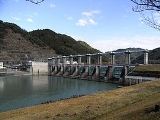
Funagira Dam
Encyclopedia
The is a dam
on the Tenryū River
, located in Tenryū-ku
, Hamamatsu, Shizuoka Prefecture
on the island of Honshū
, Japan
.
Japanese government in the early 20th century. The Tenryū River was characterized by a high volume of flow and a fast current. Its mountainous upper reaches and tributaries were areas of steep valleys and abundant rainfall, and were sparsely populated, and the Tenryū River’s propensity for flooding made flood control
a priority. By the late 1960s, numerous dams had been constructed on the river’s upper and middle reaches and on several of its tributaries.
The Funagira Dam was the last major dam to be completed on the Tenryū River, and was built only 30 kilometers from the river mouth at the piedmont
point of the river. Construction work began on the Funagira Dam in 1972 and was completed by 1977 by a consortium of the Kumagaya-gumi and Nishimatsu Construction.
s. It supplies water to the nearby Funagira Hydroelectric Power Station, with a rated capacity of 32,000 kW.
Dam
A dam is a barrier that impounds water or underground streams. Dams generally serve the primary purpose of retaining water, while other structures such as floodgates or levees are used to manage or prevent water flow into specific land regions. Hydropower and pumped-storage hydroelectricity are...
on the Tenryū River
Tenryu River
The is a river arising from Lake Suwa in Okaya, Nagano Prefecture, grazing Aichi Prefecture and flowing through western Shizuoka Prefecture in central Honshū, Japan. With a length of , it is Japan's ninth longest river.-Geography:...
, located in Tenryū-ku
Tenryū-ku, Hamamatsu
is one of the seven wards of the city of Hamamatsu, Shizuoka Prefecture, Japan. It is bordered by Kita-ku and Hamakita-ku in Hamamatsu, the cities of Shimada and Iwata and towns of Mori and Kawanehon in Shizuoka, Shishiro, Tōei and Toyone in Aichi Prefecture and Iida and Tenryū in Nagano...
, Hamamatsu, Shizuoka Prefecture
Shizuoka Prefecture
is a prefecture of Japan located in the Chūbu region on Honshu island. The capital is the city of Shizuoka.- History :Shizuoka prefecture was formed from the former Tōtōmi, Suruga and Izu provinces.The area was the home of the first Tokugawa Shogun...
on the island of Honshū
Honshu
is the largest island of Japan. The nation's main island, it is south of Hokkaido across the Tsugaru Strait, north of Shikoku across the Inland Sea, and northeast of Kyushu across the Kanmon Strait...
, Japan
Japan
Japan is an island nation in East Asia. Located in the Pacific Ocean, it lies to the east of the Sea of Japan, China, North Korea, South Korea and Russia, stretching from the Sea of Okhotsk in the north to the East China Sea and Taiwan in the south...
.
History
The potential of the Tenryū River valley for hydroelectric power development was realized by the Taishō periodTaisho period
The , or Taishō era, is a period in the history of Japan dating from July 30, 1912 to December 25, 1926, coinciding with the reign of the Taishō Emperor. The health of the new emperor was weak, which prompted the shift in political power from the old oligarchic group of elder statesmen to the Diet...
Japanese government in the early 20th century. The Tenryū River was characterized by a high volume of flow and a fast current. Its mountainous upper reaches and tributaries were areas of steep valleys and abundant rainfall, and were sparsely populated, and the Tenryū River’s propensity for flooding made flood control
Flood control
In communications, flood control is a feature of many communication protocols designed to prevent overwhelming of a destination receiver. Such controls can be implemented either in software or in hardware, and will often request that the message be resent after the receiver has finished...
a priority. By the late 1960s, numerous dams had been constructed on the river’s upper and middle reaches and on several of its tributaries.
The Funagira Dam was the last major dam to be completed on the Tenryū River, and was built only 30 kilometers from the river mouth at the piedmont
Foothills
Foothills are geographically defined as gradual increases in elevation at the base of a mountain range. They are a transition zone between plains and low relief hills to the adjacent topographically high mountains.-Examples:...
point of the river. Construction work began on the Funagira Dam in 1972 and was completed by 1977 by a consortium of the Kumagaya-gumi and Nishimatsu Construction.
Design
The Funagira Dam is a hollow-core concrete gravity dam with several central spillwaySpillway
A spillway is a structure used to provide the controlled release of flows from a dam or levee into a downstream area, typically being the river that was dammed. In the UK they may be known as overflow channels. Spillways release floods so that the water does not overtop and damage or even destroy...
s. It supplies water to the nearby Funagira Hydroelectric Power Station, with a rated capacity of 32,000 kW.

